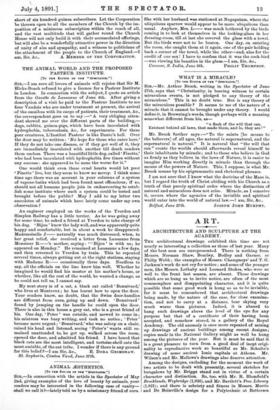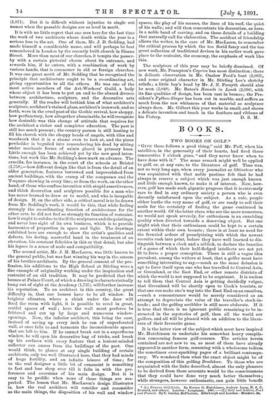ART.
ARCHITECTURE AND SCULPTURE AT THE ACADEMY.
THE architectural drawings exhibited this time are not nearly so interesting a collection as those of last year. Many of the best men are unrepresented. There is nothing from Messrs. Norman Shaw, Bentley, Bodley and Garner, or Philip Webb ; the examples of Messrs. Champneys' and T. G. Jackson's work do not cry for notice ; and some of the younger men, like Messrs. Letbaby and Leonard Stokes, who were so well to the front last season, are absent. Those drawings which are so hung as to invite notice, are often of the most commonplace and disappointing character, and it is quite possible that some good work is hung so as to be invisible, for it must be . remembered that architectural drawings being made, by the nature of the case, for close examina- tion, and not to carry at a distance, bear sluing very much worse than pictures. Indeed, it is absurd to hang such drawings above the level of the eye for any purpose but that of a certificate of their having been accepted, and somehow stored, in a gallery of the Royal Academy. The old anomaly is once more repeated of mixing up drawings of ancient buildings among recent designs; copies made in the National Gallery might as well be hung among the pictures of the year. But it must be said that it is a great pleasure to turn from a good deal of inept origi- nality to reproductive work so beautiful as Mr. Schultz's drawing of some ancient Ionic capitals at Athens. Mr. Wilson's and Mr. Mallows's drawings also deserve attention.
Among the designs, excluding for the moment the work of two artists to be dealt with presently, several sketches for bungalows by Mr. Briggs stand out in virtue of a certain character and distinction. So, too, with Mr. R. Blomfield's Brooklands, Weybrid' ye (1,936), and Mr. Bartlett's Free Library (1,921); and there is sobriety and fitness in Messrs. Morris and De Boinville's design for a Polytechnic at Battersea
(1,871). But it is difficult without injustice to single out names when the passable designs are so level in merit.
It is with no little regret that one sees here for the last time the work of two architects whose death within the year is a serious loss to the art. One of them, Mr. J. D. Sedding, had made himself a considerable name, and will perhaps be best remembered in London by the recently built church in Sloane Street. More than most of our churches, it tempts the passer. by with a certain pictorial charm about its entrance, and rewards him, if he enters, with a combination of work by various hands, that is commoner in old or foreign churches. It was one great merit of Mr. Sedding that he recognised the principle that architecture ought to be a co-ordinating art, giving opportunities to all the others. He was one of the most active members of the Art-Workers' Guild, a body whose object it has been to put an end to the absurd divorce between architecture, sculpture, and the decorative arts generally. If the reader will bethink him of what architect's sculpture, architect's stained glass, architect's ironwork, and so forth, were in the cruel past of the Gothic revival, how shoppy, how perfunctory, how altogether abominable, he will recognise how desirable was this change of attitude that requires for the architect a richer and completer education. The past is still too much present ; the country parson is still basting to fill his church with the choppy heads of angels, with tiles and woodwork that it is a shame even to look at, and the pions pewholder is beguiled into remembering his dead by sitting under mechanic forms of saints glazed in primary hues. Little enough has been achieved yet by the new good inten- tions, but work like Mr. Sedding's does mark an advance. The crucifix, for instance, in the court of the schools at Bristol (1,758),—how different design like that is from the detail of an older generation, features borrowed and impoverished from ancient buildings, with the cramp of the compasses and the T-square showing in every line ; or from the work, on the other hand, of those who confuse invention with stupid assertiveness, and think decoration and sculpture possible for a man who has never learned to draw or to model, and who is incapable of design. If, on the other side, a critical moral is to be drawn from Mr. Sedding's work, it would be this, that while feeling strongly the co-ordinating function of architecture for the other arts, he did not feel so strongly its function of restraint, how it ought to subdue to itself the sculptures and the paintings, and never lose sight of its own business, which is to provide harmonies of proportion in space and light. The drawings exhibited here are enough to show the artist's qualities and defects, his daring, masterful hand in the treatment of an elevation, his constant felicities in this or that detail, but also his lapses in a sense of scale and compatibility.
The second artist, Mr. J. M. MacLaren, was little known to the general public, but was fast winning his way in the esteem of his brother-architects. By the general consent of the pro- fession, his additions to the High School at Stirling were a fine example of originality working under the inspiration and restraint of an old tradition. It may be predicted that the houses at Palace Court, of which a drawing is characteristically hung out of sight at the Academy (1,735), will further increase his reputation. To an architect in this country, the great difficulty is, that our houses have to be all window. In brighter climates, where a chink under the door will flood the room with light, it is possible to revel in great, restful spaces of wall ; here the wall must perforce be frittered and cut up by large and numerous window- openings. Now, the inferior architect, this being the case, instead of saving up every inch he can of unperforated wall, at once falls to and torments the inconsiderable spaces that are left to him. If he cannot break out in a superfluous window, he will open his decorative bag of tricks, and break up his surfaces with every feature that a lenient-minded collector can amass from the buildings of the past. One would think, to glance at any single building of certain architects, only too well illustrated here, that they had minds of huge fertility, and an infinite leisure of time ; for to the real designer a little bit of ornament is something to fast and lose sleep over till it falls in with the pre- ferences and aversions of his main design. But it is easy to be prolific when none of these things are sus- pected. The lesson that Mr. MacLaren's design illustrates is, how the real architect will consider and reconsider as the main things, the disposition of his wall and window
spaces, the play of his masses, the lines of his roof, the quiet of his walls; and will then concentrate his decoration, as here, in a noble band of carving, and on those details of a building- that naturally call for elaboration. The accident of friendship allows the writer, in the case of Mr. MacLaren, to remember the critical process by which the too florid fancy and the too• great collection of traditional devices in his earlier work gave place to the restraint, the economy, the emphasis of work like this.
The sculpture of this year may be briefly dismissed. Of new work, Mr. Frampton's Caprice has most distinction ; there is delicate observation in Mr. Onslow Ford's bust (2,083),, and some original character in Mr. Stirling Lee's sketchy reliefs ; a little boy's head by Mr. J. N. Forsyth should also be seen (2,049). Mr. Bates's Bounds in Leash (2,096), with its fine qualities of design, has been cast in bronze ; the Pre- sident's Python-Slayer has been cut in marble, and suffers as- much from the raw whiteness of that material as sculpture always does. Mr. Gilbert this year works in small, and shows a delicate invention and touch in the feathers and ribbons of











































 Previous page
Previous page